ikfoundation.org
The IK Foundation
Promoting Natural & Cultural History
Since 1988


BONNETS AROUND THE WHITBY COAST
– Tradition and Practical Function in Colour
This essay will focus on a small group of bonnets known today as ‘Staithes bonnets’ since they were used in this coastal village longer than anywhere else. However, headgear of this kind was also popular with fishing and farming women in and around Whitby. These bonnets were usually sewn from light-coloured cotton qualities, preferably printed with tiny patterns of one or at least two shades and made by the women themselves, female relatives, local seamstresses or sold in shops. Checked cotton was also popular, while black fabric was chosen during mourning. The style’s origin was a padded and shaped headscarf with raised longitudinal bands. A selection of photographs taken by the famous photographer Frank Meadow Sutcliffe during the period 1880s-1910s highlights the everyday use of such a traditional garment, together with close-up details of typical fabric and some observations of contemporary use of the word “bonnet” in local newspaper advertisements.
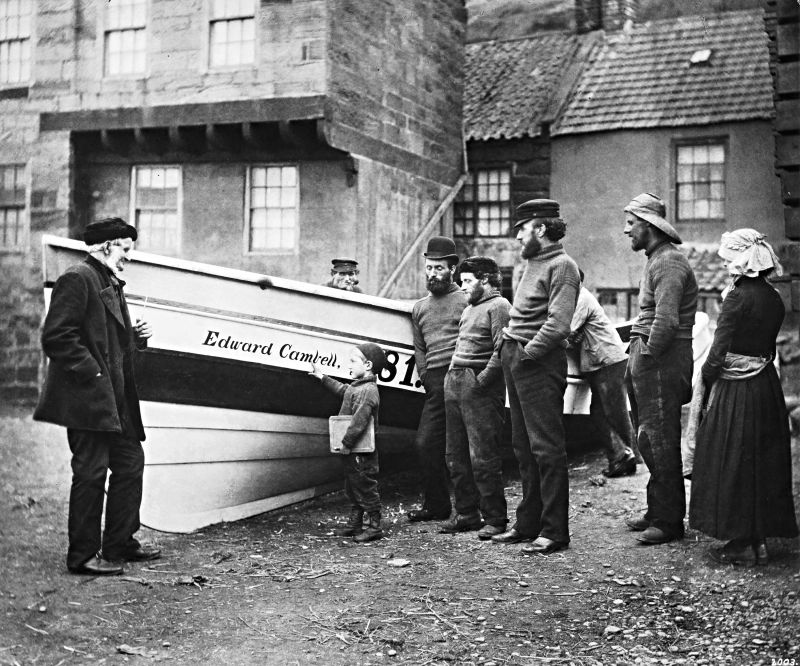 Frank Meadow Sutcliffe (1853-1941) documented in a masterly manner daily life in Whitby along the North Sea coast and the surrounding district – he had begun his career as a studio photographer, which remained his most significant source of work. Local inhabitants were photographed in his studio, and many visitors wanted their pictures taken during their holidays by the sea. But it became his close observations of the Whitby fishing community that made him famous. One such photograph of interest is this picture from Whitby of the boat ‘Edward Cambell’ and a group of local fishermen with family members in the 1890s. In the context of this particular essay, notice the woman’s traditional bonnet, with its raised longitudinal bands, which enabled the wearer to carry baskets on her head. At the same time, the extension at the back prevented water from running down her neck. Whilst most of the men and the small boy wore woollen knitted ganseys. (Courtesy: Private Collection. Public Domain). Photo: Frank Meadow Sutcliffe.
Frank Meadow Sutcliffe (1853-1941) documented in a masterly manner daily life in Whitby along the North Sea coast and the surrounding district – he had begun his career as a studio photographer, which remained his most significant source of work. Local inhabitants were photographed in his studio, and many visitors wanted their pictures taken during their holidays by the sea. But it became his close observations of the Whitby fishing community that made him famous. One such photograph of interest is this picture from Whitby of the boat ‘Edward Cambell’ and a group of local fishermen with family members in the 1890s. In the context of this particular essay, notice the woman’s traditional bonnet, with its raised longitudinal bands, which enabled the wearer to carry baskets on her head. At the same time, the extension at the back prevented water from running down her neck. Whilst most of the men and the small boy wore woollen knitted ganseys. (Courtesy: Private Collection. Public Domain). Photo: Frank Meadow Sutcliffe.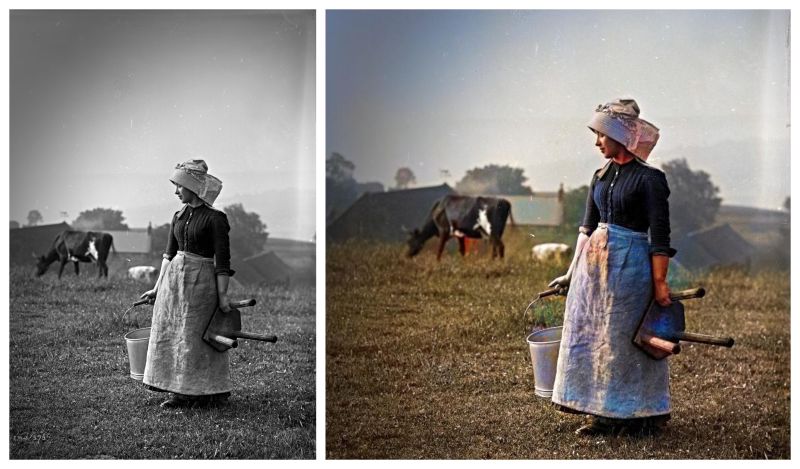 A second photograph by Frank Meadow Sutcliffe shows evidence that the traditional bonnet was also used in the local farming community. Furthermore, this – portrait of Lorna McNeil in 1902 at Low Hawsker just outside Whitby – is one of several photographs of young women wearing a bonnet when doing everyday work on farms. The poke at the front also gave protection from the sun. This collage, including modern digital colouring of the old glass plate photograph, is informative as it uniquely reveals the often preferred white and red cotton fabric for the bonnets. (Courtesy: Whitby Museum, Photographic Collection, Sutcliffe 14-9) & added modern digital colouring.
A second photograph by Frank Meadow Sutcliffe shows evidence that the traditional bonnet was also used in the local farming community. Furthermore, this – portrait of Lorna McNeil in 1902 at Low Hawsker just outside Whitby – is one of several photographs of young women wearing a bonnet when doing everyday work on farms. The poke at the front also gave protection from the sun. This collage, including modern digital colouring of the old glass plate photograph, is informative as it uniquely reveals the often preferred white and red cotton fabric for the bonnets. (Courtesy: Whitby Museum, Photographic Collection, Sutcliffe 14-9) & added modern digital colouring.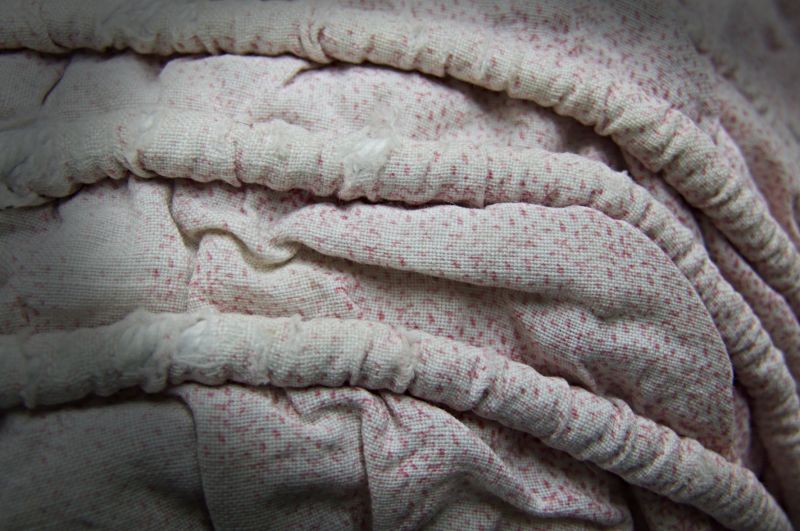 For both portrayed women above, it is detectable that the chosen fabric had small-scale motifs or a checked structure of either printed or woven cotton. This is one typical example of material and design on one of the bonnets in the Whitby Museum collection. The raised longitudinal corded bands are also in focus on this close-up detail of a traditional bonnet of printed cotton. (Collection: Whitby Museum, Costume Collection, C11). Photo: Viveka Hansen, The IK Foundation.
For both portrayed women above, it is detectable that the chosen fabric had small-scale motifs or a checked structure of either printed or woven cotton. This is one typical example of material and design on one of the bonnets in the Whitby Museum collection. The raised longitudinal corded bands are also in focus on this close-up detail of a traditional bonnet of printed cotton. (Collection: Whitby Museum, Costume Collection, C11). Photo: Viveka Hansen, The IK Foundation.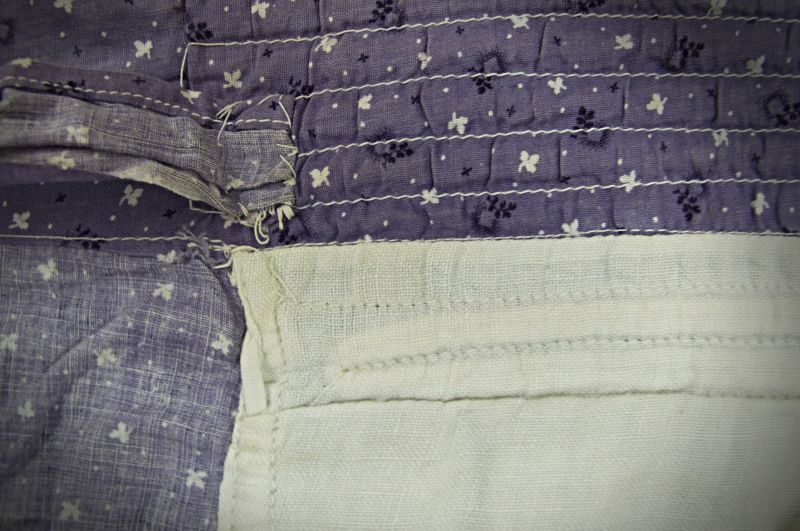 A second example shows the white lining and how the machine stitching was part of the overall design of the printed purple cotton quality. Like the one illustrated above, this bonnet originates from an unknown owner living in or around Whitby circa 1890s-1910s. During the research of censuses from the period 1841 to 1911, though, the only woman who specifically described herself as a ’bonnet maker’ was the 57-year-old widow Mary Harrison, who lived in Church Street in 1871. In the following decades, bonnets were also sold in a shop on the High Street in the coastal village of Staithes. Equally, it may be assumed that such headgear was sewn locally at home or by seamstresses in the Whitby area. (Collection: Whitby Museum, Costume Collection, C12). Photo: Viveka Hansen, The IK Foundation.
A second example shows the white lining and how the machine stitching was part of the overall design of the printed purple cotton quality. Like the one illustrated above, this bonnet originates from an unknown owner living in or around Whitby circa 1890s-1910s. During the research of censuses from the period 1841 to 1911, though, the only woman who specifically described herself as a ’bonnet maker’ was the 57-year-old widow Mary Harrison, who lived in Church Street in 1871. In the following decades, bonnets were also sold in a shop on the High Street in the coastal village of Staithes. Equally, it may be assumed that such headgear was sewn locally at home or by seamstresses in the Whitby area. (Collection: Whitby Museum, Costume Collection, C12). Photo: Viveka Hansen, The IK Foundation.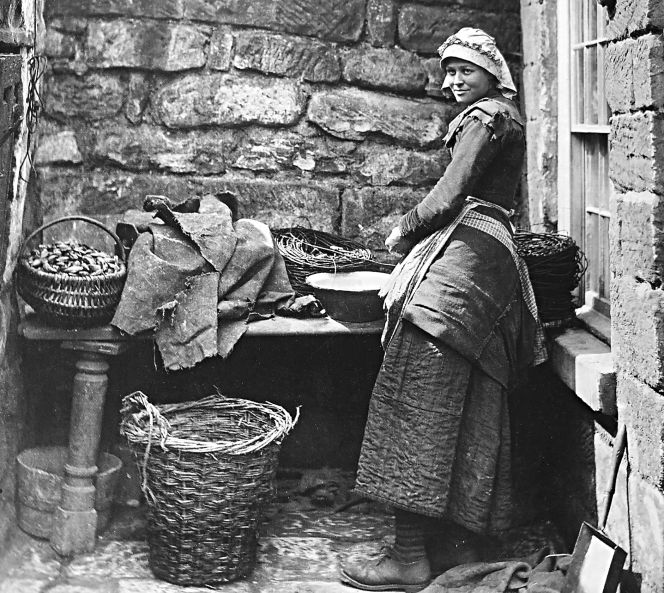 A third photograph,’ Girl bating lines’ taken by Frank Meadow Sutcliffe in the coastal village of Runswick Bay (north of Whitby) circa 1880, also gives a detailed view of a young woman’s traditional bonnet. The other garments of her working dress consisted of a quilted petticoat worn underneath her woollen dress, which was necessary for warmth and durability during hard outdoor work in the fishing communities along the Yorkshire coast. Some women’s work included baiting lines, cleaning mussels or collecting bate along the beaches. (Courtesy: Whitby Museum, Photographic Collection, Sutcliffe. 4-8, part of the photo).
A third photograph,’ Girl bating lines’ taken by Frank Meadow Sutcliffe in the coastal village of Runswick Bay (north of Whitby) circa 1880, also gives a detailed view of a young woman’s traditional bonnet. The other garments of her working dress consisted of a quilted petticoat worn underneath her woollen dress, which was necessary for warmth and durability during hard outdoor work in the fishing communities along the Yorkshire coast. Some women’s work included baiting lines, cleaning mussels or collecting bate along the beaches. (Courtesy: Whitby Museum, Photographic Collection, Sutcliffe. 4-8, part of the photo).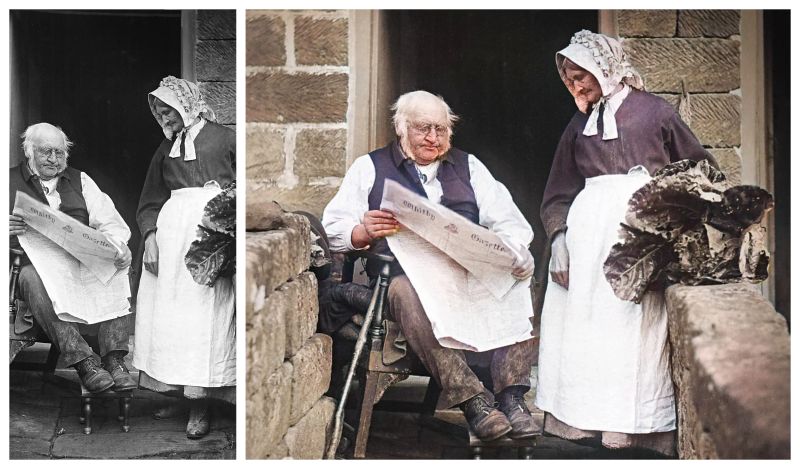 This Frank Meadow Sutcliffe photograph reveals that elderly ladies also wore the traditional bonnet, but in her case, the drawstring ribbon was tied under the chin. The married couple was portrayed – carefully posed – outside their cottage in the nearby village of Glaisdale within the North York Moors around 1900. (Courtesy: Whitby Museum, Photographic Collection, Sutcliffe. B-36, part of the photo). & To the right modern digital colouring of the old glass plate photograph.
This Frank Meadow Sutcliffe photograph reveals that elderly ladies also wore the traditional bonnet, but in her case, the drawstring ribbon was tied under the chin. The married couple was portrayed – carefully posed – outside their cottage in the nearby village of Glaisdale within the North York Moors around 1900. (Courtesy: Whitby Museum, Photographic Collection, Sutcliffe. B-36, part of the photo). & To the right modern digital colouring of the old glass plate photograph.The many artists known as the Staithes Group also illustrated women and girls in the coastal fishing village of Staithes wearing bonnets immediately before and after the turn of the century in 1900. Their paintings were contemporary with Frank Meadow Sutcliffe’s photographs. A few such examples are: “Fisherwomen by the Quay at Staithes” and “Fisherfolk at Brunswick” by Frederick William Jackson (1859-1918), “Low Tide” by Harold Knight (1874-1961) and “Old Peggie” by Mark Senior (1862-1927).
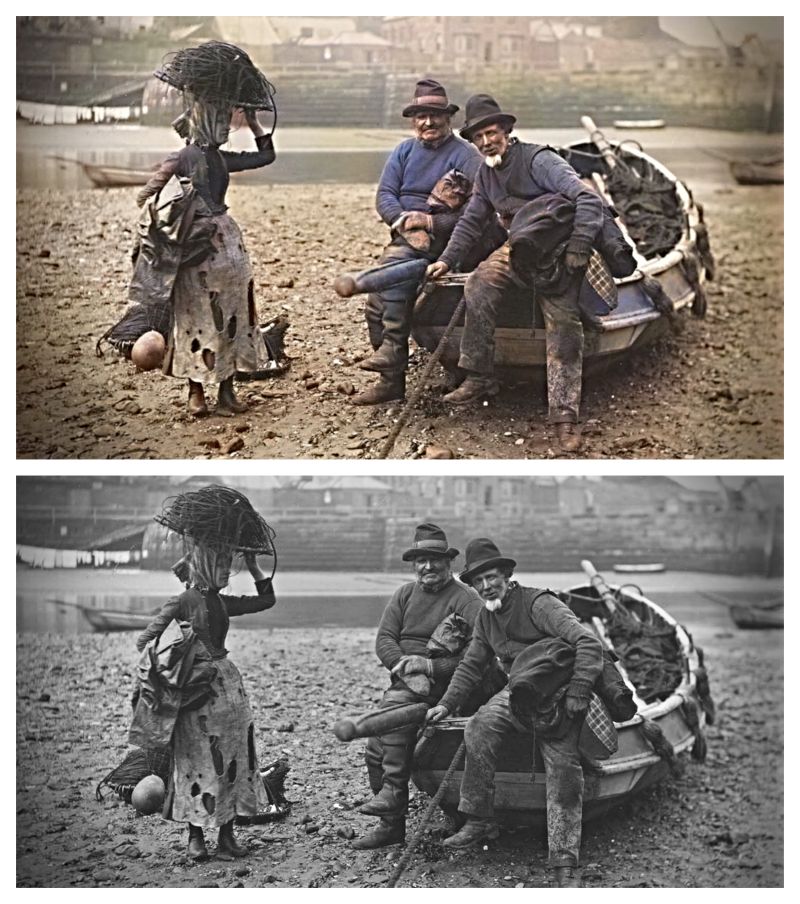 Whitby Harbour circa 1890. (Photo: Frank Meadow Sutcliffe. Wikimedia Commons, Public Domain). & The top part is modern digital colouring of the old glass plate photograph.
Whitby Harbour circa 1890. (Photo: Frank Meadow Sutcliffe. Wikimedia Commons, Public Domain). & The top part is modern digital colouring of the old glass plate photograph.Even if many of Sutcliffe’s photographs clearly showed the portrayed individuals to their best advantage, due to a continuous photographic tradition influenced via earlier portrait painters who had often visualised their subjects as more beautiful than they really were, the same tradition lived on in Victorian studio photographs – and to some extent outdoors. It was seen as vital to choose poses and expressions to show the subject’s most attractive sides and most desirable character traits in the best possible light, and backgrounds and accessories could be used to draw attention to the subject’s social status or societal station. However, the photograph above, from Whitby Harbour around 1898, demonstrates the harsh reality for fishermen, particularly the woman in the picture, who prepared hundreds of hooks for long-line fishing and gathering the bait in baskets along the coast. She was clearly underweight due to hard work, poor nutrition or other factors and dressed in very worn-out clothes – even more visible in the modern digital colouring of the original black and white photograph. In the context of her headgear, it is visible that she used an ordinary headscarf tied under the chin instead of the traditional bonnet. Judging by an in-depth study of Sutcliffe’s photographic collection, wearing regular headscarves made of various woven or knitted designs seems to have been just as common for women and girls in the Whitby fishing community.
In additional words, bonnets were also advertised in the local newspaper, Whitby Gazette. Still, due to the wording in such adverts, these seem to have been more fashionable models for women and children alike. For instance, a female proprietor of the time – Mrs Coates of St Ann’s Staith – catered for women and children only. On 3rd July 1858, she offered her customers Baby linen, Satin and other Bonnets, Hats, Hoods, Hosiery, Summer Dresses, Jackets, Mantles, &c., suitable for the Seaside’. It can be supposed that many of her customers were in Whitby as visitors during the summer months and needed to supplement their wardrobes with garments suitable for sun, beach and leisure. Some years later, R. Proud, a draper in Lion Bank, announced in the summer of 1865 a wide variety of female clothes and accessories, including: ‘Laces. Bonnet Fronts. Muslin & Linen Sets. Stays’. In Baxter Gate more than thirty years later was David Hume, who on 25th August 1899 had on offer a ‘Surplus Stock of Mantles, Jackets, Capes, Coats & Skirts... Remaining Stock of Blouses, Shirts, Ties, Collars, Fichus, Ostrich Feather Boas, Sunshades, Skirts, Sun hats and bonnets, Millinery, &c. All specially reduced.’
Sources:
- Hansen, Viveka, The Textile History of Whitby 1700-1914 – A lively coastal town between the North Sea and North York Moors, London & Whitby 2015. (pp. 100-114, 237, 255 & 281).
- Haworth, Peter, Paintings by Members of The Staithes Group, UK 2002.
- Hiley, Michael, Frank Sutcliffe: Photographer of Whitby, Chichester 2005.
- Staithes, England. (Visits to the coastal village of Staithes in 1999 & 2007).
- Sythes, D.G., (compiled by), The Archive Photographs Series Around Whitby, Whitby 1997.
- Whitby, North Yorkshire County Library. Census 1841-1901 microfilm. (Research visits in 2006).
- Whitby Museum, Whitby Lit. & Phil., England. | Library and Archive: original papers of Whitby Gazette 1855-1911. |Photographic Collection – Frank Meadow Sutcliffe. | Costume & Textile Collection: preserved bonnets. (Research visits 2007-2011).
More in Books & Art:
Essays
The iTEXTILIS is a division of The IK Workshop Society – a global and unique forum for all those interested in Natural & Cultural History from a textile Perspective.
Open Access essays, licensed under Creative Commons and freely accessible, by Textile historian Viveka Hansen, aim to integrate her current research, printed monographs, and earlier projects dating back to the late 1980s. Some essays feature rare archive material originally published in other languages, now available in English for the first time, revealing aspects of history that were previously little known outside northern European countries. Her work also explores various topics, including the textile trade, material culture, cloth manufacturing, fashion, natural dyeing, and the intriguing world of early travelling naturalists – such as the "Linnaean network" – viewed through a global historical lens.
For regular updates and to fully utilise iTEXTILIS' features, we recommend subscribing to our newsletter, iMESSENGER.
been copied to your clipboard




– a truly European organisation since 1988
Legal issues | Forget me | and much more...
You are welcome to use the information and knowledge from
The IK Workshop Society, as long as you follow a few simple rules.
LEARN MORE & I AGREE







